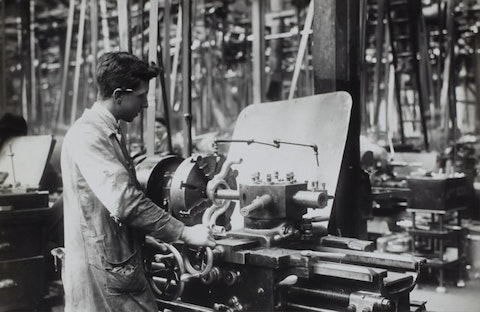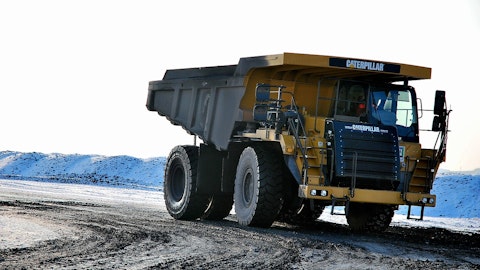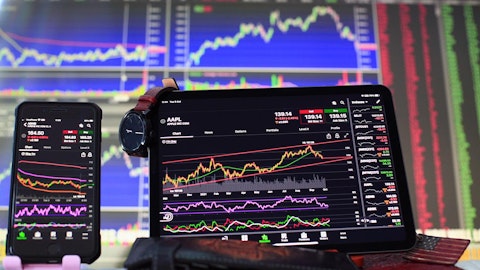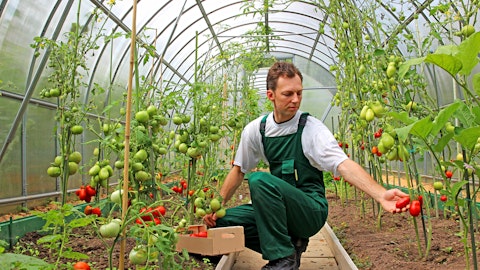CNH Industrial N.V. (NYSE:CNHI) Q4 2022 Earnings Call Transcript February 2, 2023
Operator: Good day, and welcome to today’s CNH Conference Call and Webcast. At this time, I’ll hand the call over to Jason Omerza. Please go ahead.
Jason Omerza: Thank you, Serge. Good morning and good afternoon to everyone. We would like to welcome you to the webcast and conference call for CNH Industrial’s Fourth Quarter and Full-Year Results for the period ending December 31, 2022. This call is being broadcast live on our Web site, and is copyrighted by CNH Industrial. Any other use, recording or transmission of any portion of this broadcast without the expressed written consent of CNH Industrial is strictly prohibited. Hosting today’s call are CNH Industrial’s CEO, Scott Wine; and CFO, Oddone Incisa. They will use the material available for download from the CNH Industrial Web site. Please note that any forward-looking statements that we might be making during today’s call are subject to the risks and uncertainties mentioned in the Safe Harbor statement included in the presentation material.
Additional information pertaining to the factors that could cause actual results to differ materially is contained in the company’s most recent report 20-F and EU annual report, as well as other periodic reports and filings with the U.S. Securities and Exchange Commission, and the equivalent authorities in the Netherlands and Italy. The company presentation includes certain non-GAAP financial measures. Additional information, including reconciliations to the most directly comparable U.S. GAAP financial measures, is included in the presentation material. I will now turn the call over to Scott.
Scott Wine: Thank you, Jason. And thanks, everyone, for joining our call. We finished 2022 with solid results as fourth quarter revenues were up over 27%, driving full-year consolidated revenues up 21%. Deliveries and product mix improved in both Agriculture and Construction. Our strength was broad-based, with double-digit year-over-year price realization coming from all regions. We expanded profit margins in both Agriculture and Construction despite significant input cost increases. The industry faced many other headwinds during the year, including a choppy supply chain, elevated freight costs, and ongoing inflation. Late in the year, these issues began to modestly improve. And we anticipate that will continue into 2023. The CNH team’s creativity, hard work, and strong execution resulted in company records for both adjusted net income, up $2 billion for the year, and adjusted earnings per share, at $1.46, up 14% over 2021.
We also generated $2 billion in free cash flow from industrial activities in the fourth quarter and $1.6 billion for the full-year as we over-delivered on our plans to complete and ship our accumulation of partially built units. This benefited our dealers and put us in a net cash position well ahead of our plan. Last year, we launched two potent margin improvement initiatives, the Strategic Sourcing Program, and the CNHI Business System, which we refer to as CBS. Continuous improvement is hard, especially in pursuit of breakthrough results. But our team has embraced this lean mindset, and is poised to deliver value across the business. Looking ahead, we remain focused on executing our strategy, including significant investments in out tech stack and product development.
Derek Neilson and his team continue to drive exceptional performance, delivering a strong fourth quarter, with full-year net sales for the AG business up 22%. This growth was largely propelled by robust industry demand and significant year-over-year price realization, especially in North and South America. We saw improved product mix, including Precision AG revenues up 32%, which benefited from both an increased take rate for factor-fit precision options and incremental rate in sales. AG profitability remained healthy, with Q4 gross margins up 280 basis points, and adjusted EBIT margin up 310 points admittedly against an easy comp. Margins were down sequentially versus our record third quarter performance impacted by regional mix and the non-standard work required to finished units.
Overall, I’m extremely pleased with the AG team’s performance and results. For 2022, AG adjusted EBIT was nearly $2.5 billion, marking our highest profit in more than a decade. We are executing on our customer-centric strategy and customers have responded with continued demand for our high-end products at prices offsetting increased escalated production cost. They have also recognized us with improved net promoter scores, 5% higher than in 2021. Derek and his team are ensuring that customer is at the center of all we do, driving the right behaviors and results. Stefano Pampalone and his Construction team executed quite well in the fourth quarter with strong momentum from Sampierana integration, manufacturing improvements, and enhanced customer focus; we expect even better progress in 2023, and beyond.
2022 net sales were up 16% for both the full-year and the fourth quarter, with noteworthy growth in Europe and South America. Organic growth accounted for about two-thirds of the increase in the remainder, with the remainder attributed to Sampierana. Their excavator portfolio and technology innovations have enhanced our ability to meet customer needs, and their Eurocomach platforms provide an outstanding foundation for electrification. Construction adjusted EBIT for the quarter was $34 million at a 3.5% margin. Full-year adjusted EBIT was up 38%, to $124 million. And we are encouraged by the ongoing progress in Construction. The team is well-positioned to deliver on their strategic initiatives, support their dealers and customers, and gain market share.
This past December, we held an engaging Tech Day to showcase our extensive suite of precision AG technology. Attendees met our deep team of experts in automation, autonomy, and connected platforms to better understand the cutting edge products we are developing. Through a series of live demo stations, the team exhibited the real world applications of our groundbreaking . The products and technology that we demonstrated at Tech Day that you see here on this page and those we will be releasing over the next few years, prove our commitment to being a leader in precision agriculture. We reiterate our expectation to deliver over $1 billion of Precision AG sales in 2023. I also want to highlight two recent investments made through our CNH Industrial Ventures arm.
Stout Industrial Technology is a U.S.-based startup focused on AI-powered smart agriculture implements. EarthOptics has proprietary sensor technology that precisely measures soil health and structure. By taking minority stakes in these and similar companies through our Ventures portfolio, CNH is staying on the cutting edge of emerging technology to develop solutions to provide real advantages for customers. CHN remains committed to adding value and creating profitable growth for its customers and shareholders through sustainability. We have a strong history of sustainability performance as evidenced by our recognitions and our innovative products, including the New Holland methane tractor and electric mini excavator pictured here. In 2022, we pledged to set science-based targets that will enhance our operation’s Scope 1 and 2 emissions goals, and establish a first-time decarbonization goals related to our products, which we’ll announce later this year.
With that, I will turn it over to Oddone to take you through our financial results. Oddone?
Oddone Incisa: Yes, thank you, Scott, and good morning, good afternoon to everyone on the call. So, fourth quarter net sales from Industrial Activities, of nearly $6.4 billion, were up over 27% net of adverse FX impacts. Full-year net sales of Industrial Activities, of $21.5 billion, were up 21% or over 24% at constant currency. Continued price adjustments were significant drivers for the top line growth in the quarter, and volume and mix also accounted for around 15% sales increase from Q4, 2021. Our Industrial segment’s fourth quarter gross margin was 21.7%, and 22.2% for the full-year. The year-over-year margin improvement, of 1.5 points, is mainly due to strong and profitable growth in South America, and disciplined price realization globally, which more than offset rising productions cost.
Q4 adjusted EBIT came in at $680 million, up $302 million from 2021, with a corresponding EBIT margin of 10.7%, a 310 business points improvement versus prior year. Full-year adjusted EBIT of Industrial Activities was $2.4 billion with a margin of 11.3%, up 140 basis points from 2021. Free cash flow from Industrial Activities was $1.6 billion in 2022, which turned our initial Industrial Activities net debt into a net cash position of $362 million at the end of the year, as Scott discussed in his introductory slide. Adjusted net income for the quarter was $486 million, up $61 million compared to prior year. This resulted in adjusted earnings per share of $0.36, up $0.05 year-over-year, and full-year adjusted EPS was $1.46. Adjusted net income for the quarter was affected by a higher tax rate due to discreet items booked in Q4.
The full-year adjusted effective tax rate was about 28% mainly due to the jurisdictional mix of pre-tax profit with higher rates coming from South America. And we will likely see the tax rate a point or two lower in 2023. Available liquidity, as of December 31, was $10.6 billion. And at the Annual General Meeting, the Board of CNH Industrial is planning to recommend an annual cash dividend of $0.36 per common share, totaling a little over $500 million in distribution to shareholders. In the fourth quarter, strong volumes and double-digit price realization continued to shield us from the steep increase in production costs. R&D and our SG&A expenses were higher by technology investments, inflation, and newly acquired businesses. Energy costs increased year-over-year but still accounted for about half-a-percent of our total costs worldwide.
Agriculture adjusted EBIT increased by $287 million, to reach $701 million with a margin of 13.1%, up more than 300 basis points from the same quarter in 2021. The higher profits were driven by higher volumes and favorable pricing, which offset higher products cost, SG&A, and R&D expenses. Gross profit was up $394 million compared to Q4 2021, exceeding $1.2 billion with a margin of 13.1%. For the full-year, gross profit was up $989 million or up 140 basis points from 2021 largely driven by strong price realization coming from all regions and better product mix, including margin-rich technology-related sales growing by about 32%. Construction Equipment adjusted EBIT for Q4 increased by $14 million compared to Q4 2021, reaching $34 million with a margin of 3.5%.

Photo by Museums Victoria on Unsplash
These results were driven by favorable volume and positive price realization. But product cost, including site-related costs, were an outsized headwind for the business. Gross profit across the year was up $82 million compared to the full-year 2021, mainly due to higher volumes and stronger pricing. For our financial service business, net income in the fourth quarter was $75 million, down $50 million compared to 2021. Factors include high risk cost, provisions linked to the termination of the construction business in China, increased labor cost, and compressed margin in North America slightly mitigated by robust volumes across the region as well high recovery on those agreements. Retail originations were $2.9 billion in the quarter reaching $10 billion for the year, up to $100 million from 2021.
The managed portfolio at the end of 2022 was $23.8 billion, up $4 billion on a constant currency basis. Delinquencies remained at a low level, up 10 basis points year-over-year to 1.3%. Increase from December 2021 is explained by the in-sourcing of the resolving credit account portfolio that was purchased in October 2022. CNH Industrial Capital America acquired receivables previously held by CD on a private label program that will now be run and booked by our company. Free cash flow from industrial activities in the quarter was over $2 billion on the back of $1.5 billion change in working capital driven in large part by the reduction in manufacturing inventory as we mentioned before. At the end of the year, the total gross debt for industrial activity was $5 billion with a net cash position of $362 million.
So, within the first year of the spin-off, we were able to improve our net financial position by $1.5 billion on the back of the cash generated by the operations. This takes to our capital allocation priorities. And we have target spending $4.4 billion in combing R&D and CapEx over the 2022 – 2024 plan period, almost doubling what we were spending in the previous three years. In 2022, we spent the first $1.3 billion of that. And we remain committed to invest in our business to fuel profitable growth. We are confident the product and service we would bring to the market with the spending will ensure higher financial performance in the near future, and more importantly, higher efficiencies to our customers. Strong cash generation helps us maintaining our investment grade rating which has been re-affirmed or improved by all the rating agencies after the spin-off.
We returned nearly $600 million to shareholders in 2022 through dividend and share repurchases. And as mentioned earlier, we proposed — the proposed 2023 dividend itself will total above $500 million. And we plan continuing our share buyback program. We have the liquidity to funding organic growth and you are seeing use the ventures on for minority investments when opportunity arises. We remain committed to our capital allocation strategy and focus on maximizing value for our shareholders. This concludes my prepared remarks. And I will now turn it back to Scott.
Scott Wine: Thank you, Oddone. Overall, demand continues to outstrip the industry’s ability to supply at least in the near term, which despite record sales has actually dampened the industry levels. Spot commodity prices are trending down. But they are still generally above pre-2022 levels. And fortunately for farmers, fertilizers and other input cost are dropping as well. In North America, elevated farm incomes are sustaining demand for high horsepower tractors and combines. While small tractor demands has slowed from a lofty level seen over the past two years. We see the European Ag industry flattening as the macro-environment starts to impact equipment demand there. South America and Brazil in particular is a very good market for us.
The business conditions in Brazil are inflexed following a presidential election. But we believe that the fundamentals are still positive for agriculture in the region. We also see good long-term opportunities in APAC. But this year will likely be slightly down. In construction, global demand is trending is lower. And we expect residential and commercial markets in North America and Europe to decline in 2023 due to rising interest rates. However, public construction spending at least partially fills in those gaps in United States. In Europe and South America, construction markets will be down in reaction to the overall macro-environment. We expect net sales of industrial activities to increase 6% to 10%. With confidence in the stickiness of our 2022 price increases, we expect to build on our margin gains by taking more cost out of our system.
We are committed to growing market share. And we have the products, brands, and dealer network to do just that. Returning to full production in our North American plants will also help. Our SG&A as a percentage of sales remains one of the lowest in the industry. And despite inflationary pressures, we will severely limit SG&A growth. Free cash flow will be between $1.3 billion and $1.5 billion. A little lower than last year as we have earmarked $1.6 billion for R&D and CapEx, up about $300 million from 2022. Even accounting for the increased R&D cost, our EBIT is projected to grow slightly faster than our top line. We are becoming a simpler, leaner company every day. And expect to modestly improve our industrial margins throughout the year. Earlier today, we announced that our Board of Directors has determined that our shareholders would be best served by a single listing in United States.
The majority of our trading in CNH Industrial stock has been shifting to the New York Stock Exchange since the snip-off of Iveco Group. Revealing that CNH’s new business profile and investor base better fit with the single New York Stock Exchange listing. Concentrating trading in one market will allow for increased liquidity of our stock, improve investor focus, further simplify the company’s profile, enable broader index inclusion, and attract more passive investors. The current Italian regulations only permit the delisting of stocks when they are or will be listed on another EU exchange. By definition, the stock exchange does not qualify. CNH Industrial has an open dialog with Borsa Italiana on Euronext. And we told them about of our intention to leave the European listing.
The harmonization and modernization of the Italian financial system, which is underway, is expected to include the New York Stock Exchange as an acceptable exchange. This is our preferred path for smooth delisting from Euronext Milan. But not the only option if this becomes untimely. We are targeting sole trading on NYSE by the end of 2023. But that could shift into 2024 depending on the timing of the regulation change. Rest assured, we will delist it soon as it is legally possible. At this point, we do not intend to change our incorporation in the Netherlands or our tax domicile in U.K. as part of the single listing. Therefore, we do not expect any material tax or trading consequences for our shareholders. Our Board of Directors and management team are grateful to Euronext Milan for being our listing venue for the past 10 years, and excited about the company’s full return to the NYSE.
I want to stress that this does not change the company’s longstanding commitment to Italy and the Italian market. CNH employees over 5000 people in Italy made a significant investment with Sampierana acquisition in late 2021, opened its fifth plant in the country in 2022. We also have three R&D centers in Italy developing products that are sold around the world. While the delisting is another step in corporate simplification, real value creation comes from the business. We are now taking orders into Q4 in some markets. And overall demand remained strong. But the uncertain macro-environment, especially toward the end of 2023 requires vigilance as we strive to support our customers, dealers, suppliers, and employees. We expect to escalate combine CapEx and R&D investment as we launch exciting new products and build out the tech stack.
We have already introduced some Raven-enabled products, and we will unveil more in 2023. But the real payoff for these higher margin precision solution kicks in 2024. We are happy to have finally secured a contract with UAW North America. The agreement we reached is fair for our employees and sustainable for the company. Employees returned to work this week. And we expect the two affected plants to ramp up to full production in the coming months. While the pace of inflation is slowing, it is still inflation. And we expect it to have an impact on our manufacturing, energy, SG&A, and R&D cost in 2023. On a more positive note, we are seeing modest supply chain improvements. Our primary margin improvement initiative, strategic sourcing, and CBS will start to yield results in 2023.
I want to close by emphasizing again how proud I am of the team for what they have accomplished. And ensure you that we are ready to do even more in 2023. That concludes our prepared remarks. And I will now turn call over to Serge to open the line for questions.
See also 20 Least Populated States in America and 13 Best Value Dividend Stocks to Buy.
Q&A Session
Follow Cnh Industrial N.v. (NYSE:CNHI)
Follow Cnh Industrial N.v. (NYSE:CNHI)
Operator: Thank you, sir. And our first question comes from Kristen Owen from Oppenheimer. Please go ahead.
Kristen Owen: Hi, good morning. Thank you for the question. Scott, you talked about some of the industry demand outlook for 2023, I was wondering if you could comment more on some of the order book trends that were outlined in the press release? If I recall, last quarter, you talked about some of the year-over-year declines being driven more by your intentional decision to keep order books relatively short. How far are you open now, and maybe just say more about how you view demand versus order levels for 2023?
Scott Wine: Yes. As we talked about, the macro environment is — it’s choppy a little bit, and you see that in everything you read. But our order books really are not open. We haven’t opened up Q4 in any markets yet, and we still are allocating. So, a lot of what’s happening in the order book is our choice to allocate markets. I mean it’s — I’m not proud of the fact, but we have not delivered on a timely manner in much of 2022. The one market where we’ve been very clear is down is low horsepower tractors. So, we are seeing softness there. And I mentioned, I referred to the political situation in Brazil, it’s really provide a — just taking farmers, I think, are just taking a pause. We think the fundamentals in that market are incredibly strong; the world needs that agriculture production and they need equipment in order to do that.
But we’re just watching that very closely. But overall, Europe is a little bit slightly down, but we feel good about our ability to execute and keep that market relatively flat to the way it was in 2022. So, overall, I think the demand environment is better than I would have expected to be at this point. And we’re really, I mean, running our factories as fast as we can and as much as we can through the year, and just being careful as we look at the fourth quarter. The fourth quarter is where we are being cautious at this point. We don’t have orders for that yet, but where we have talked about it, I think we could open that up and probably book it very quickly.
Kristen Owen: Okay, that’s helpful. And then just as a follow-up to that question, just how you’re thinking about dealer inventory levels existing 2023, do you expect to produce in line with dealer inventories, builds, just any comments you have there?
Scott Wine: We are still — again with the exception of the low horsepower tractors, we are still below historical levels, and really, quite frankly, still below where most of our dealers would like us to be with our inventory. So, we’re going to work to catch that up. We do not plan to get back to historical levels. We’d like to keep inventory relatively lean. It’s careful balancing there, because you’re running as fast as you can to provide shipments, and the market is going to slow down at some point. But no, we are not looking to push a lot more dealer inventory into the channel. We’ve got some dealers build that we’ve got to do just to give them acceptable levels of inventory. But our goal and part of what we’re watching for is to make sure we protect dealer inventories going into 2024.
Kristen Owen: Great, thank you.
Operator: Thank you. Our next question comes from Steven Fisher from UBS. Please go ahead.
Steven Fisher: So, thanks. Good morning. Just on the Q4 order book point, just curious, Scott, why haven’t you opened up the order books yet? And what will you need to see to fully open them up for Q4?





